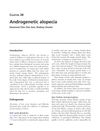Oral minoxidil gives hair everywhere except scalp,plss help Minoxidil 3/2/2025
Oral minoxidil is causing body hair growth but not improving scalp hair, despite using dutasteride and finasteride. Users suggest waiting longer for results, checking vitamin levels, and considering additional treatments like topical minoxidil, dermarolling, and supplements.
View this post in the Community →
Similar Community Posts Join
5 / 1000+ resultscommunity Dutasteride thins eyebrows and facial hair but doesn't stop scalp loss.
Dutasteride may not effectively stop scalp hair loss and can cause thinning of facial and body hair, including eyebrows. Users suggest considering other causes like autoimmune conditions or vitamin deficiencies and exploring treatments like finasteride or minoxidil.
community Study shows further evidence that finasteride and dutasteride take 12-18 months or more to show significant results. Do NOT give up early
The conversation discusses the effectiveness of finasteride and dutasteride in treating hair loss, emphasizing that significant results often take 12-18 months or more. Dutasteride is generally considered superior, with similar or fewer side effects than finasteride, but patience is required for noticeable improvement.
community 10 months on fin and hairline destroyed.
A user experienced severe hair shedding and hairline recession after 10 months on finasteride. They are considering switching to dutasteride or adding minoxidil.
community 18M 8 months progress 40mg daily dut stack
An 18-year-old is using a high-dose hair loss treatment with 40mg daily dutasteride, finasteride, minoxidil, tretinoin, and topical bicalutamide. Despite health risk concerns, especially liver issues, they report hair regrowth progress and intend to continue the regimen.
community Another update. Almost a year on Dutasteride and Oral Minoxidil, after several years on finasteride and topical minoxidil. I’m fairly certain my hair is objectively worse than it was 5 months ago.
A user's experience with hair loss treatments, including Dutasteride, Oral Minoxidil and Finasteride; potential side effects; and the potential of using anti-androgens or microneedling.
Related Research
6 / 1000+ results
research Androgenetic Alopecia: A Review and Emerging Treatments
Hair loss, known as Androgenetic Alopecia, is often caused by hormones and can be diagnosed using noninvasive techniques. Treatments include topical minoxidil and oral finasteride, with new treatments being explored. There may also be a link between this type of hair loss and heart disease risk.

research Overactive Bladder in Men: Finasteride for Androgenetic Alopecia
Finasteride increases hair count and improves hair growth with low risk of side effects.

research Recent Advances in Understanding of the Etiopathogenesis, Diagnosis, and Management of Hair Loss Diseases
New understanding and treatments for hair loss are improving, but more research is needed.

research Safety Concerns When Using Novel Medications to Treat Alopecia
Consider benefits and risks of new alopecia treatments for safety.

research Female Pattern Alopecia: Current Perspectives
Female pattern hair loss is caused by multiple factors and while treatments like topical minoxidil, hormone therapy, and low-level light therapy can help, none can fully cure it.

research Interventions for Female Pattern Hair Loss
Topical minoxidil helps treat female pattern hair loss, but more research needed for other treatments.